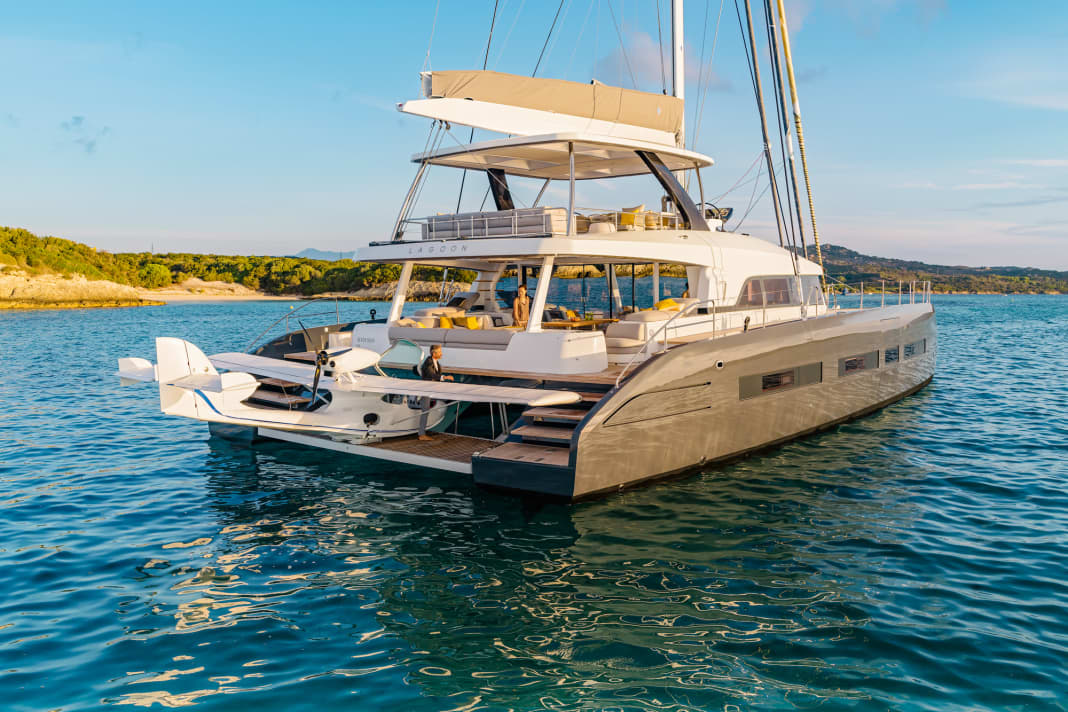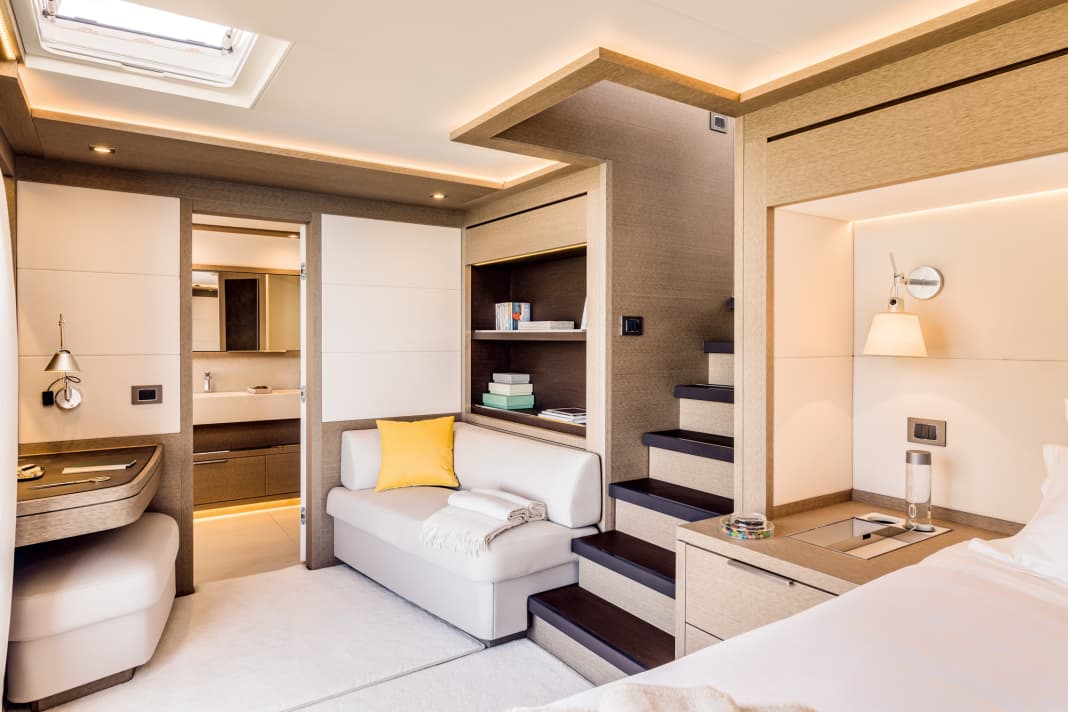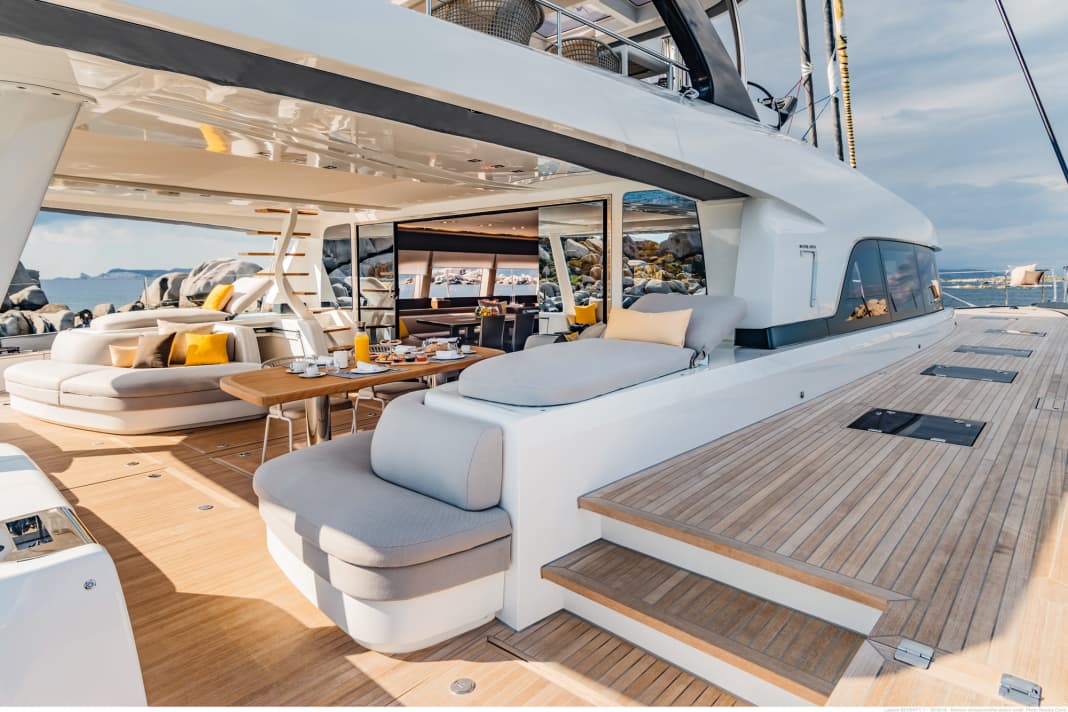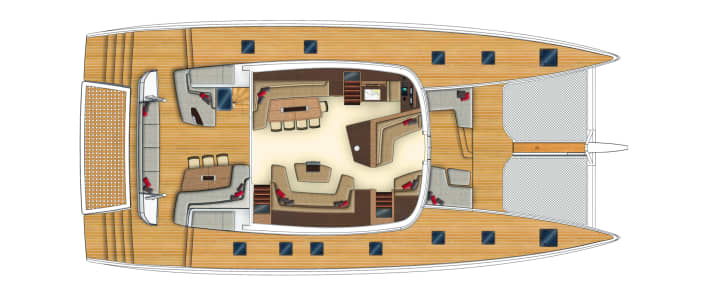





It is a trend that cannot be denied: sailing catamarans between 60 and 100 feet are in demand like never before and are conquering the market unstoppably. So it was only a matter of time before the Lagoon brand, which is part of the Beneteau Group, expanded its range of production boats into the large yacht segment. "The development of the Seventy 7 was based on requests from customers who wanted to expand," explains Lagoon boss Yann Masselot. With eleven models currently in its portfolio, the global twin-hull market leaders count more than 600 owners with catamarans longer than 50 feet among their customers worldwide. "We deliberately developed the Seventy 7 as a superyacht with a very high standard of equipment and space for a crew of up to four and plenty of living space for the owner and their guests," says Masselot. It is therefore not surprising that a compact seaplane was also given a decisive role as a sexy aero tender in the product shoot - goodbye understatement!
High demand
The sales figures prove the French right and confirm the Group's excellent market intuition. The Lagoon flagship, which costs €2,850,000 in the basic package, was unveiled at the end of 2016 and sold twelve times by spring 2017. As the shipyard director commented at the time, they were sold out by 2020. The hope was that eight Seventy 7s could be delivered per year by 2019.
Lagoon catamarans have been particularly popular in Asia for years, so it seems only natural that half of the flagships sold to date have been delivered to this growing market. There are good reasons for the catamaran boom of recent years. "Thanks to their two hulls and enormous width, catamarans are much more stable in the water than monohulls, and not just when anchored, which is a decisive criterion in itself for many of our owners and, of course, their wives. Added to this is the enormous amount of space below and on deck for the length of the yacht," explains Head of Marketing Alexandre Dauberville. "No monohull of similar length comes close to offering a saloon that is as open and bright as the saloon of the Seventy 7," enthuses Dauberville. "In addition, there are numerous lounge and seating areas in the interior and on deck that are inviting and offer every guest a place to retreat."
Construction of the Seventy 7
When building the 23.28 metre Seventy 7, the Beneteau Group benefits from its broad-based shipyard portfolio and utilises the outstanding semi-custom expertise of its subsidiary CNB. The Lagoon giant is being built as a sandwich (GRP on balsa core, keels as solid laminate) using the vacuum infusion process in the CNB halls in Bordeaux, which are reserved for large formats. Bureau Veritas signs the class papers, with MCA certification on request. The design office Van Peteghem Loriot Prévost, VPLP for short, which specialises in fast multihulls, is responsible for the successful appearance of the flagship and worked closely with former car designer Patrick Le Quément on the exterior design. The modern, warm interior styling and the successful open-plan layout were created by Nauta Design from Milan.
In keeping with the semi-custom concept, Lagoon offers the Seventy 7 with three to five cabins and two different room layouts for the port hull (galley in the bow or stern). The owner also has a choice of three contemporary, albeit very different, versions (Nomad, Pure, Fusion) for the ambience and the dominant colour scheme.
Layout of the Lagoon catamaran
The shipyard realised construction number one of the eleven-metre-wide catamaran with a spacious guest cabin in the bow of the port hull, with its own access from the saloon. Behind this is the crew area with a cabin and a professional galley that would make even star chefs happy - a separate companionway ensures short working distances and as much privacy as possible for owners and guests. In the starboard hull, the owner lives in a suite that has never before been realised in a catamaran. A private companionway leads into the owner's 25 square metre realm, which has been skilfully and elegantly divided into three zones by the Nauta design team led by Massimo Gino: There is an open walk-in wardrobe at the front, a large double bed behind it and a desk, sofa and large bathroom at the rear. The suite can be further extended at the touch of a button - a watertight hatch extends hydraulically from the hull and becomes an impressive owner's terrace just above the waterline. Although Lagoon only offers this extra, developed in cooperation with the Italian hardware specialists from Besenzoni, as an option, it is clear that €90,000 could hardly be better invested. Life can only get better this close to the water.



Even more innovations on board
Like the owner's cabin, the saloon has another new feature: for the first time, the shipyard has realised a swinging door at the front of the superstructure, which ensures a harmonious and barrier-free transition between the interior and the bow cockpit directly in front of it. With its two L-shaped sofas, this lounge area, which is elegantly set into the deck, is one of the cosiest zones on board. When dolphins accompany the Seventy 7, the bow basket seats and trampolines are transformed into perfect viewing platforms. Those who prefer more shade can move to the aft cockpit, which is covered by the fly, with a dining table for eight people and a sofa area behind it. Cooking and mixing can be done right next to it if required; a galley island houses hotplates, grill, sink and fridges. For colder climes, the cockpit can be closed off with a robust window cover and transformed into a cosy winter garden. With their generous dimensions, the side decks have earned the name "boulevard decks".




A spiral staircase leads from the cockpit to the flybridge, which is shaded by a hardtop and from which the boat is steered and sailed. Thanks to glass inserts in the hardtop, the captain also has a good view of the sails from the two helm stations equipped with modern navigation and communication equipment. Five electric Harken winches help with setting the sails and trimming. A dining table is also available up here for sundowner dinners with a view, while the large sofa aft is perfect for an aperitif.
Model created by Lagoon for passionate sailors
Despite the impressive amount of space on and below deck, the Seventy 7 is a true sailing yacht. "We want to build fast-sailing catamarans that also appeal to passionate sailors," says Yann Masselot. This is confirmed by a sail plan with an impressive sail area. The 36.60 metre high aluminium mast from Sparcraft (carbon optional) included in the standard package carries 337 square metres of laminate from Incidence Sails upwind, while the crew uses a 500 square metre gennaker on rough courses. In calm conditions, two Volvo Penta diesels with a combined output of 270 kilowatts push the 57-tonner into the next anchorage. There, the tender - or the compact aeroplane - is then lowered into the water using a hydraulic bathing platform. Thanks to a shallow draught of just 1.90 metres, even shallow areas can be included in the itinerary.
The new Seventy 7 will further boost the triumphal march of the twin-hulls and convince owners who previously doubted the concept. Those who can overlook the rather bulky exterior of the superyacht catamarans and the sometimes significantly higher marina mooring fees will be rewarded with a level of space that no monohull of this size can offer. Lagoon is also planning even longer catamarans. "We are talking to many customers about the realisation of one-off projects," says shipyard boss Masselot. "The interest is huge and I don't think it will abate for the time being."
Technical data
- Length over everything: 23,28 m
- Width:11,00 m
- Depth:1,90 m
- Displacement (empty):57 t
- Material: GRP balsa sandwich, keel solid GRP laminate
- Motor: 2x Volvo Penta D4
- Motor: 2x Volvo Penta D4kW
- Rig: Aluminium mast and boom
- Mast height: 36,60 m
- sail area: 337 square metres
- Furler: Rake
- Fuel:2.800 l
- Water: 1.600 l
- Galley: Miele
- Navigation: B&G
- Construction: VPLP
- Exterior design:Patrick Le Quément
- Interior design: Nauta
- Classification: Bureau Veritas
- Shipyard:Lagoon/CNB, 2016
- Price: from 2,850,000 euros



